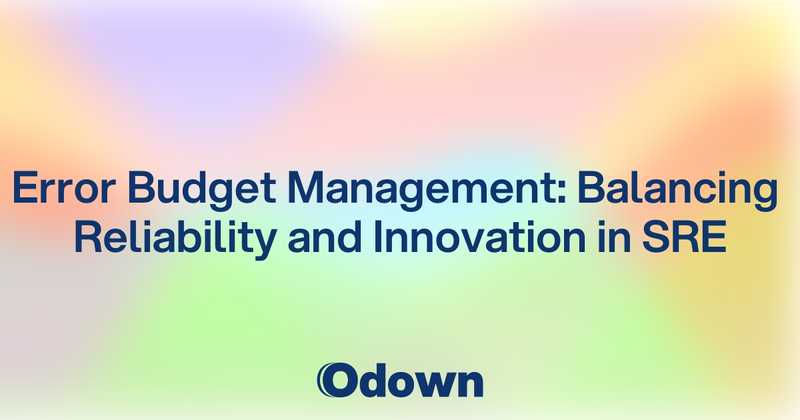Error Budget Management: Balancing Reliability and Innovation in SRE
Your development team wants to ship new features faster. Your operations team wants perfect uptime. Your executives want both innovation and reliability, but they don't want to double your engineering budget. This tension between moving fast and staying stable destroys more engineering teams than any technical challenge ever could.
Error budgets solve this problem by turning reliability from an abstract goal into a concrete resource that teams can spend wisely. Instead of arguing about whether 99.9% uptime is "good enough" or whether that new feature is worth the deployment risk, you can have data-driven conversations about how to spend your error budget most effectively.
Companies that master error budget management stop treating reliability and innovation as opposing forces. They learn to invest their error budget strategically - spending it on features that matter while banking it for experiments that might fail. This approach enables sustainable development velocity without sacrificing the stability that customers demand.
Understanding Error Budgets in SRE Practice
Error budgets quantify how much unreliability your service can tolerate while still meeting user expectations and business requirements. Instead of aiming for perfect uptime, you establish acceptable reliability targets and then manage the difference between perfect reliability and your target as a resource.
If your service level objective (SLO) is 99.9% uptime, your error budget is 0.1% downtime - roughly 43 minutes per month. This error budget represents the unreliability you can "spend" on new deployments, infrastructure changes, experiments, and inevitable failures without violating your reliability commitments.
The genius of error budgets lies in making reliability tradeoffs explicit and measurable. When teams argue about deployment frequency or feature rollout strategies, error budgets provide objective data for making decisions. If you have error budget remaining, you can afford to take calculated risks. If you've exhausted your error budget, you need to focus on stability until it replenishes.
The Mathematics of Reliability
Error budgets work because they transform reliability from a binary concept into a continuous measurement. Traditional approaches treat downtime as complete failure - any outage means you've "failed" at reliability. Error budgets recognize that some amount of unreliability is inevitable and economically optimal.
Perfect reliability is infinitely expensive. Going from 99% to 99.9% uptime requires significant investment. Going from 99.9% to 99.99% requires even more investment, and the pattern continues exponentially. Error budgets help you find the reliability level that balances user satisfaction with development velocity and infrastructure costs.
Error budget calculations depend on accurate SLO definitions and measurement methodologies. If your SLO is "99.9% of requests succeed within 500ms," you need systems that can measure request success rates and response times accurately. Poor measurement leads to poor error budget decisions.
Error Budget as Currency
Think of error budgets as currency that your engineering team can spend on various activities that might impact reliability. Deploying new code costs some error budget because deployments sometimes introduce bugs. Infrastructure changes cost error budget because they might cause temporary instability.
This currency model helps teams make informed tradeoffs about risk and value. A critical security fix might be worth spending significant error budget. A cosmetic UI change probably isn't worth much error budget expenditure. Marketing-driven feature deadlines can be evaluated against available error budget rather than arbitrary urgency.
Different activities have different error budget costs based on their risk profiles. Well-tested, gradual rollouts cost less error budget than emergency hotfixes deployed without normal testing procedures. Understanding these costs helps teams optimize their reliability spending.
Organizational Alignment Through Error Budgets
Error budgets create shared vocabulary and incentives between development and operations teams. Instead of having abstract arguments about "moving fast" versus "being stable," teams can have concrete discussions about error budget allocation and spending priorities.
Product managers can make informed decisions about feature tradeoffs when they understand the reliability costs of different approaches. Engineering managers can justify infrastructure investments by demonstrating how they reduce error budget consumption for future features.
Executive leadership gets clear visibility into the relationship between reliability investments and development velocity. This transparency helps with resource allocation decisions and expectation setting across the organization.
Implementing Error Budget Policies
Effective error budget management requires clear policies that define how teams should behave when error budgets are healthy, stressed, or exhausted. These policies remove emotional decision-making from reliability choices.
Error Budget States and Actions
When error budgets are healthy (typically when you've consumed less than 50% of your monthly budget), teams can operate in high-velocity mode. This means normal deployment cadence, experimental feature rollouts, and infrastructure optimization projects can proceed without special approval.
When error budgets become stressed (consuming 50-90% of monthly budget), teams should implement more conservative practices. This might mean slowing deployment frequency, requiring additional testing for changes, or postponing risky infrastructure projects.
When error budgets are exhausted (consuming 90%+ of monthly budget), teams should focus exclusively on reliability improvements until error budget replenishes. No new features, no experimental deployments, no infrastructure changes that aren't directly related to improving reliability.
Escalation and Override Procedures
Sometimes business requirements override error budget policies. Critical security fixes can't wait for error budget to replenish. Regulatory compliance deadlines might require feature deployments despite exhausted error budgets.
Establish clear escalation procedures for override decisions that involve appropriate stakeholders. Override decisions should require explicit approval from engineering leadership and product management, with clear understanding of the reliability risks involved.
Document override decisions and their outcomes to improve future error budget policies. Understanding when and why teams override error budget constraints helps refine the policies and improve decision-making frameworks.
Cross-Team Error Budget Sharing
Large organizations often have interdependent services that share error budget implications. When service A depends on service B, reliability problems in service B consume error budget for service A even though service A's team didn't cause the issue.
Develop error budget sharing models that account for service dependencies and shared infrastructure. This might involve allocating error budget proportionally across teams or creating shared error budget pools for common infrastructure components.
Consider creating error budget markets where teams can transfer unused error budget to other teams that need additional reliability tolerance for important projects. This creates incentives for teams to maintain high reliability while enabling flexibility for strategic initiatives.
Measuring and Tracking Error Budgets
Accurate error budget tracking requires robust measurement systems that capture reliability data continuously and calculate error budget consumption in real-time.
Service Level Indicator Selection
Choose service level indicators (SLIs) that meaningfully represent user experience rather than just technical system health. Request success rate and response time SLIs often correlate better with user satisfaction than server uptime metrics.
Ensure your SLIs capture the reliability characteristics that actually matter to your users. An e-commerce site might care more about checkout success rate than homepage load time. A real-time communication app might prioritize message delivery latency over web interface responsiveness.
Use multiple SLIs to capture different aspects of service reliability, but avoid creating so many SLIs that error budget calculations become too complex to understand and act upon. Three to five key SLIs typically provide sufficient coverage for most services.
Error Budget Calculation Methods
Time-based error budgets calculate reliability over fixed time windows like monthly or quarterly periods. This approach works well for services with consistent usage patterns and provides predictable error budget replenishment schedules.
Request-based error budgets calculate reliability based on the number of requests rather than time periods. This approach better handles services with variable traffic patterns where error budget consumption should correlate with actual user impact.
Rolling window calculations provide more responsive error budget tracking than fixed time periods. A 30-day rolling window adjusts continuously rather than resetting monthly, which provides better visibility into recent reliability trends.
Real-Time Error Budget Monitoring
Implement error budget dashboards that show current consumption, trending patterns, and projected error budget exhaustion dates. Teams need visibility into error budget status to make informed decisions about upcoming changes.
Set up alerting for error budget consumption thresholds that align with your policy states. Alert when error budget consumption crosses into stressed territory, and escalate alerts when approaching exhaustion.
Track error budget consumption attribution to understand what activities or failures are consuming your reliability tolerance. This helps teams optimize their error budget spending and identify areas for reliability investment.
Historical Analysis and Trending
Analyze error budget consumption patterns over time to identify seasonal trends, recurring issues, and improvement opportunities. Historical data helps refine SLOs and error budget policies based on actual usage patterns.
Track the relationship between error budget consumption and business metrics like user engagement, conversion rates, and customer satisfaction. This helps validate that your SLOs actually correlate with business outcomes.
Use error budget data to inform capacity planning and reliability investment decisions. Services that consistently exhaust error budgets need reliability improvements, while services that never consume error budget might have overly conservative SLOs.
Strategic Error Budget Allocation
Smart error budget management involves strategic allocation decisions that maximize value from reliability spending while maintaining user satisfaction.
Feature Development Planning
Integrate error budget considerations into feature planning and prioritization processes. High-value features might justify significant error budget expenditure, while low-impact features should minimize reliability risk.
Consider the error budget cost of different implementation approaches during architectural design. More complex implementations typically cost more error budget due to increased failure possibilities and deployment complexity.
Plan feature rollout strategies that optimize error budget consumption. Gradual rollouts with feature flags typically cost less error budget than big-bang deployments, even though they might take longer to complete.
Infrastructure Investment Decisions
Use error budget data to justify infrastructure reliability investments. Improvements that reduce error budget consumption for ongoing operations create capacity for future feature development.
Prioritize infrastructure projects based on their impact on error budget efficiency. Monitoring improvements, deployment automation, and automated rollback capabilities often provide high return on reliability investment.
Consider the long-term error budget implications of architectural decisions. Microservices architectures might cost more error budget initially but provide better error budget isolation as systems scale.
Risk Management and Experimentation
Allocate error budget for controlled experimentation that might improve reliability or development velocity. A/B testing new deployment approaches or infrastructure configurations requires error budget investment but can improve long-term efficiency.
Reserve error budget for emergency response and unexpected failures. Maintaining some error budget buffer helps teams respond to incidents without immediately violating SLOs.
Use error budget allocation to encourage appropriate risk-taking. Teams that never spend their error budget might be too conservative and missing opportunities for valuable improvements.
Advanced Error Budget Practices
Mature error budget implementations go beyond basic tracking to create sophisticated reliability management frameworks that adapt to business needs and organizational complexity.
Multi-Service Error Budget Management
Complex applications with multiple interdependent services need error budget models that account for service dependencies and failure propagation patterns. Failures in core services consume error budget for all dependent services.
Implement error budget models that reflect the actual user experience rather than individual service reliability. Users don't care if service A is reliable if service B failures prevent them from completing their workflows.
Consider implementing hierarchical error budgets where high-level user journeys have error budgets that cascade down to component services. This approach aligns error budget consumption with actual business impact.
Error Budget Banking and Transfer
Develop mechanisms for teams to bank unused error budget for future use or transfer error budget between teams with different reliability needs. This creates incentives for maintaining high reliability while providing flexibility for strategic initiatives.
Implement error budget markets where teams can negotiate error budget transfers based on business priorities and technical dependencies. This approach helps optimize organization-wide error budget allocation.
Consider seasonal error budget adjustments that account for predictable business cycles. E-commerce sites might need higher error budgets during holiday seasons, while business applications might need more reliability during month-end processing.
Error Budget Integration with Business Metrics
Connect error budget consumption to business outcome measurements to validate that your reliability investments align with actual user value. This helps refine SLOs and improve error budget allocation decisions.
Track the cost of error budget consumption in terms of engineering time, infrastructure resources, and opportunity cost for other projects. This economic view of reliability helps with investment prioritization.
Use error budget trends to predict future reliability needs and plan capacity investments accordingly. Services with increasing error budget consumption might need architectural improvements or infrastructure scaling.
Error budget management transforms reliability from a binary success/failure metric into a strategic resource that enables sustainable development velocity. Teams that master error budget practices can innovate faster while maintaining the reliability that customers demand.
The investment in error budget frameworks pays dividends in improved team alignment, better risk management, and more informed technical decision-making. Instead of guessing about reliability tradeoffs, teams can make data-driven decisions that optimize for both innovation and stability.
Ready to implement error budget management? Odown provides the SLI measurement and error budget tracking capabilities that make effective error budget management possible. Combined with our stress testing methodologies and database optimization techniques, you'll have comprehensive tools for managing reliability as a strategic business resource rather than just a technical constraint.



